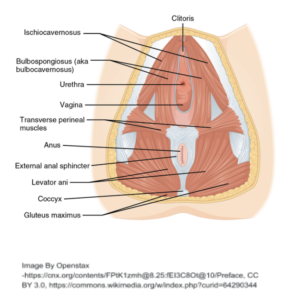CAN YOUR LOW BACK, SI JOINT, HIP, OR GLUTE PAIN BE CAUSED BY A TIGHT PELVIC FLOOR?
Yes!
First, some basic essential background information to help this make sense.
The pelvic floor is made up of muscles and connective tissue attached to the bones at the bottom of the pelvis and tailbone. One or more of the muscles can be affected.
The tense muscle itself can be the point where discomfort or pain is experienced. Personally, I experienced this in two ways: firstly, as a constant burning sensation, like a urinary tract infection, but it can be a different type of painful sensation; and secondly as pain during sex.
Tense muscles can’t do their job properly. They aren’t able to relax and contract in a full range of motion and they become tired and weak. Other muscles attached to or near the pelvis and tailbone have to work harder in a way they’re not meant to, to make up for the decreased function of the pelvic floor muscles.
Common consequences and symptoms of a tense pelvic floor include, but aren’t limited to:
- Decreased mobility of the hip joints, spine
- Tight hip flexors and/or hamstrings
- Low back tightness and pain, tailbone pain, glute pain, hip pain or SI joint pain
- Urinary incontinence (leaking)
- Other urinary issues (having to wee frequently, having an uncontrollable sudden urge to wee, pain during urination, having trouble starting a wee, having a slow flow, not being able to empty fully)
- Bowel issues (constipation, issues with emptying the bowels, faecal incontinence)
- Developing/progressing pressure in the pelvic floor
- Developing/progressing pelvic organ prolapse (bladder, uterus, and/or rectum sink into the vaginal wall)
So, Why Does This Happen? What causes the pelvic floor muscles to become tense in the first place?
Well, there’s not always a simple answer. To eliminate the problem and stop it from recurring, it’s necessary to find the root cause or causes of YOUR tense pelvic floor.
The following is not a full listing of causes, but gives you a good idea of what I’m talking about.
- The abdominals are in charge of stabilising the spine and top of the pelvis. If they don’t do a complete job, other muscles, which can include the pelvic floor muscles, will jump in to help. When a muscle does more than its regular job, it develops tension and tightness. Eventually, pain and dysfunction result.
- Holding tension in the body can cause tension to be held in the pelvic floor. This frequently occurs when experiencing fear, stress, anxiety and trauma. Given the amount of stress we face in daily life compared to the time we take to fully de-stress, resolve issues, and calm the nervous system, it’s no wonder that this is a common contributor.
- Postural changes common in (but not limited to) the perinatal period (both during pregnancy and after birthing) can lead to muscle compensation, including holding more tension in the pelvic floor muscles.
- Tissue trauma from childbirth, whether vaginal or C-section, can be painful and cause a guarding reaction of increased tension in muscles.
- Scar tissue development in the pelvic floor or abdomen, from childbirth or surgery, causes pulling on tissues and a change in muscle function, including overactivity and tightness.
- Gut issues such as irritable bowel syndrome (IBS), chronic bloating and chronic constipation can result in excess tension in the pelvic floor.
- Pain experienced during menstrual periods (By the way, these are NOT normal, so please find a healthcare professional who can help you with this!) and endometriosis can cause frequent, recurrent tensing up against the pain.
- Habitually holding your abdominals tight or sucked in to make it look flatter means the abdominals are chronically over-activated. Because the abdominals and pelvic floor influence one another, this often results in a chronically over-activated, hypertonic pelvic floor.
- Unbalanced muscle use and tightness or activation is another factor. For example, the habit of gripping the glutes (keeping the bottom muscles squeezed) causes tightness in the pelvic floor muscles. A second example that illustrates this is swimming breaststroke preferentially strengthens the inner thigh muscles (adductors). If these are allowed to develop chronic excess tension, an effect will be had on the pelvic floor.
- Chronic bladder or bowel holding for excessive lengths of time mean the pelvic floor muscles frequently remain tensed longer than they should. This can lead to the issues, above.
Can This Be Fixed? What Steps Can Be Taken?
YES! Tense pelvic floors and the problems they cause can be fixed or managed!
Always investigate any underlying issues with a healthcare professional who will help you get to the cause and find relief.
Visit a physiotherapist with special interest and training in women’s health, pelvic health and continence. Look for one who treats your body as a whole system, rather than just concentrating on your pelvic floor and vagina. Remember, the cause of your tight pelvic floor might not be anything wrong with your pelvic floor!
They will examine the function of your pelvic floor and other muscles and joints, and help you find the cause of your hypertonic pelvic floor or other issues. They will also be able to use a large range of techniques and strategies (specialist massage and exercise, relaxation techniques, targeted stretches of muscles of the pelvis and hips, bladder and bowel strategies, and many others) to start improving the challenges you are facing.
Depending on the issues to investigate, you might also consult a GP, specialist physician, integrative medicine specialist, naturopath, remedial massage therapist, dietician, etc.)
Ensure you develop and maintain a balanced muscle recruitment and release strategy for all your movements throughout your daily life and exercise.
It’s very easy to slip back into the movement habits, tension holding, and breathing patterns that contributed to developing the problems in the first place.
You might start this work with your physiotherapist as part of your treatment.
Following, or in conjunction with your physio treatment, seek out a specialist trainer, certified in corrective exercise and women’s health fitness and wellbeing, such as myself.
I’ll help you implement specialised exercises and strategies that will significantly increase your long-term success of maintaining a happy pelvic floor and body!
Recognise yourself in any of the above? Need help improving your core, pelvic floor, posture? Would you like to learn specialised exercises and strategies that will significantly increase your long-term success of maintaining a happy pelvic floor and body?
Private Sessions and programming dedicated to exactly what YOU require, will allow you to MAKE QUICK PROGRESS and MOVE BEYOND YOUR CHALLENGES. You’ll be able to TAKE YOUR LIFE MOVEMENT and ATHLETIC PERFORMANCE TO NEW LEVELS.
Unsure? Book a 15 Minute Discovery Call to talk to me about your aspirations and goals.


